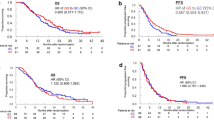Abstract
Background
The factors which affect the 6-month continuation of adjuvant chemotherapy with S-1 have not been fully evaluated in pancreatic cancer. The objective of this retrospective study was to clarify the risk factors for the discontinuation of S-1 adjuvant chemotherapy after 6 months of treatment.
Methods
The study included patients who underwent curative surgery for pancreatic cancer, were diagnosed with stage II or III disease, had a serum creatinine level ≤1.2 mg/dl and received adjuvant S-1 between June 2007 and March 2014.
Results
Forty patients were eligible for the present study. A comparison of the 6-month continuation stratified by each clinical factor using the log-rank test revealed a significant difference in the creatinine clearance (CCr) between the patients who continued and discontinued the treatment. A CCr of 60 ml/min was regarded as a critical point. The uni- and multivariate Cox’s proportional hazard analyses demonstrated that the CCr was the only significant independent predictive factor. The 6-month continuation rate was 70.8 % in the patients with a CCr ≥60 ml/min and was 25.0 % in patients with a CCr <60 ml/min (P = 0.008). The patients with a CCr <60 ml/min developed adverse events more frequently and earlier than those with a CCr ≥60 ml/min.
Conclusions
A CCr < 60 ml/min was a significant risk factor for the 6-month discontinuation of S-1 adjuvant chemotherapy in pancreatic cancer patients, even though the renal function was judged to be normal based on the serum creatinine level. Careful attention is therefore required to improve the S-1 continuation in patients with a CCr < 60 ml/min.


Similar content being viewed by others
References
International Agency for Research on Cancer, World Health Organization. Globocan 2008. World Health Organization Web site. http://globocan.iarc.fr/. Accessed 15 July 2010
Jemal A, Siegel R, Xu J, Ward E (2010) Cancer statistics, 2010. CA Cancer J Clin 60:277–300
Uesaka K, Fukutomi A, Boku N, Kanemoto H, Konishi M, Matsumoto I et al (2013) Randomized phase III trial of adjuvant chemotherapy with gemcitabine versus S-1 for resected pancreatic cancer patients (JASPAC-01 study). J Clin Oncol 31;suppl 4: abstr 145
Bonadonna G, Valagussa P (1981) Dose-response effect of adjuvant chemotherapy in breast cancer. N Engl J Med 304:101–105
Sobin LH, Wittekind CH (eds) (2002) TNM classification of malignant tumors, 6th edn. Wiley, New York
Maeda A, Boku N, Fukutomi A, Kondo S, Kinoshita T, Nagino M et al (2008) Randomized phase III trial of adjuvant chemotherapy with gemcitabine versus S-1 in patients with resected pancreatic cancer: Japan Adjuvant Study Group of Pancreatic Cancer (JASPAC-01). Jpn J Clin Oncol 38:227–229
Cockcroft DW, Gault MH (1976) Prediction of creatinine clearance from serum creatinine. Nephron 16:31–41
Shirasaka T, Shimamato Y, Ohshimo H, Yamaguchi M, Kato T, Yonekura K et al (1996) Development of a novel form of an oral 5-fluorouracil derivative (S-1) directed to the potentiation of the tumor selective cytotoxicity of 5-fluorouracil by two biochemical modulators. Anticancer Drugs 7:548–557
Tatsumi K, Fukushima M, Shirasaka T, Fujii S (1987) Inhibitory effects of pyrimidine, barbituric acid and pyridine derivatives on 5-fluorouracil degradation in rat liver extracts. Jpn J Cancer Res 78:748–755
Hirata K, Horikoshi N, Aiba K, Okazaki M, Denno R, Sasaki K et al (1999) Pharmacokinetic study of S-1, a novel oral fluorouracil antitumor drug. Clin Cancer Res 5:2000–2005
Aoyama T, Yoshikawa T, Hayashi T, Kuwabara H, Mikayama Y, Ogata T et al (2013) Risk factors for 6-month continuation of S-1 adjuvant chemotherapy for gastric cancer. Gastric Cancer 16:133–139
Yamanaka T, Matsumoto S, Teramukai S, Ishiwata R, Nagai Y, Fukushima M (2008) Safety evaluation of oral fluoropyrimidine S-1 for short- and long-term delivery in advanced gastric cancer: analysis of 3,758 patients. Cancer Chemother Pharmacol 61:335–343
Conflict of interest
None.
Author information
Authors and Affiliations
Corresponding author
Additional information
Toru Aoyama and Yusuke Katayama have contributed equally to this article.
Rights and permissions
About this article
Cite this article
Aoyama, T., Katayama, Y., Murakawa, M. et al. Risk factors for 6-month continuation of S-1 adjuvant chemotherapy for resected pancreatic cancer. Cancer Chemother Pharmacol 74, 1235–1240 (2014). https://doi.org/10.1007/s00280-014-2601-y
Received:
Accepted:
Published:
Issue Date:
DOI: https://doi.org/10.1007/s00280-014-2601-y




